Spoon
(18th and 19th Centuries )
The bowl of the spoon is inscribed in Cyrillic: "Eat to your health." Cloisonné is among the oldest methods of enameling, in which thin strips of metal are soldered to a metal base to form the cells that hold the colored enamels. In a Russian variation of cloisonné known as filigree enamel, twisted wires rather than metal strips are fastened to the base to create the cells. In Moscow, during the second half of the 19th century, filigree enameling was popular.
Inscription
Provenance
Provenance (from the French provenir, 'to come from/forth') is the chronology of the ownership, custody, or location of a historical object. Learn more about provenance at the Walters.
Mr. and Mrs. Leslie Legum, Baltimore; given to Walters Art Museum, 1989.
Conservation
| Date | Description | Narrative |
|---|---|---|
| 4/4/2016 | Examination | Gilded silver; filigree enamel |
Geographies
Russia, Moscow (Place of Origin)
Measurements
H: 7 3/16 in. (18.2 cm)
Credit Line
Gift of Mr. and Mrs. Leslie Legum, 1989
Location in Museum
Not on view
Accession Number
In libraries, galleries, museums, and archives, an accession number is a unique identifier assigned to each object in the collection.
In libraries, galleries, museums, and archives, an accession number is a unique identifier assigned to each object in the collection.
44.675




